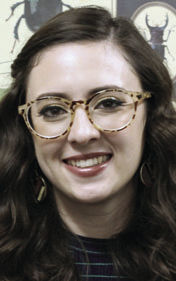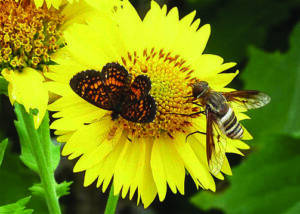
By Jeanette Castanon
Pollinators include insects such as beetles, bees, ants, wasps, butterflies and moths; of these, bees pollinate the largest number of plant species. They are certainly the most well-known pollinators to the public and are afforded more protections under the law than the others. About 1,000 species of pollinators are hummingbirds, bats and other small mammals. Even ants, thrips and spiders do their part. Some plants have evolved to create far more pollen than might be thought necessary to ensure fertilization and seed creation, because such visitors as bees and beetles eat pollen, but as they do so grains are caught on their hairs and body parts and transferred to other flowers.
Pollination occurs when pollen is moved within flowers or carried from one flower to another of the same species by birds, bees, bats, butterflies, moths, beetles or other animals, or by the wind. This transfer of pollen leads to fertilization and successful seed and fruit production. Pollination ensures that a plant will produce full-bodied fruit and a complete set of fertile seeds, capable of germinating.

Today pollinators’ existence may be threatened. Since pollinators are largely overlooked, assessing their condition and economic importance; seeking to understand their circumstances, biology, and benefits better; and working to help keep them healthy are positive, pro-active approaches to conservation. Plants that depend on a single pollinator species, and likewise, pollinators that depend on a single type of plant for food (for example, fig wasps and fig trees or monarch butterflies and milkweed plants) are interdependent. If one disappears, so will the other.
What can you do for pollinators?
- Create a pollinator-friendly garden habitat in just a few simple steps.
- Design your garden so that there is a continuous succession of plants flowering from spring through fall. Check for the species or cultivars best suited to your area and gradually replace lawn grass with flower beds.
- Plant native to your region using plants that provide nectar for adults plus food for insect larvae, such as milkweed for monarchs. If you do use non-native plants, choose ones that don’t spread easily, since these could become invasive.
- Select old-fashioned varieties of flowers whenever possible because inbreeding has caused some modern blooms to lose their fragrance and/or the nectar/pollen needed to attract and feed pollinators.
- Install ‘houses’ for bats and native bees. For example, use wood blocks with holes or small open patches of mud. As little as 12 inches across is sufficient for some bees.
- Avoid pesticides, even so-called “natural” ones such as Bacillus thuringiensis (Bt). If you must use them, use the most selective and least toxic ones and apply them at night when most pollinators aren’t active.
- Supply water for all wildlife. A dripping faucet or a suspended milk carton with a pinhole in the bottom is sufficient for some insects. Other wildlife need a small container of water.



